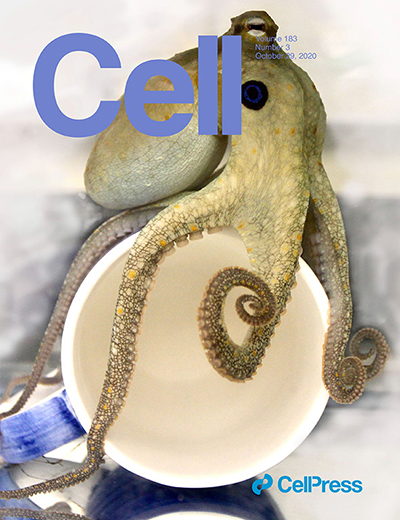Octopuses are invertebrates known for their advanced intelligence and sophisticated foraging (or escape!) behaviors. These features are facilitated by a peripherally-distributed nervous system that enables advanced sensation and processing among their long flexible arms, independent from their centralized brain. Such adaptations support the octopus’ voracious predatory behavior using its ‘touch-taste’ chemotactile arm sensation to locate and capture prey within seafloor crevices. Each arm is equipped with numerous suction cups that allow it to sense and manipulate prey, effectively serving as the octopus equivalent for both a tongue and hands. How the peripherally-distributed octopus nervous system mediates relatively autonomous arm sensation and behavior was unknown and relatively unexplored.

cover image by Lena van Giesen
In this study, we investigated ‘touch-taste’ chemosensation in octopus to identify the chemical stimuli, receptors, cells, transduction mechanisms, and associated behaviors. We characterized a novel family of chemotactile receptors (CRs) that mediate this contact-dependent, aquatic chemosensory modality. CRs are found specifically in cephalopods, are expressed in suction cups along the arms, and are evolutionarily-related to neurotransmitter receptors. Instead of responding to neurotransmitters, we found that these receptors have adapted to mediate the detection of poorly-soluble molecules from natural products proposed to act as mediators of ‘touch-taste’ sensation in aquatic environments.
Numerous CRs are co-expressed in receptor cells and form diverse ion channel complexes to specify distinct chemical signal detection and transduction. This feature allows the octopus chemotactile system to encode different environmental signals even at the level of the sensory receptor proteins, a feature suited to the octopus’ peripherally-distributed nervous system. Furthermore, we showed that the octopus uses separate and distinct chemo- and mechanosensory cells which express specific receptors and exhibit discrete electrical activities to transmit chemical and touch information, respectively. Indeed, we observed that octopuses explored their environment using stereotypical touch motions that are distinctly modified by contact with different CR agonists. Thus, our results demonstrate that the uniquely-distributed octopus nervous system exhibits exceptional environmental signal processing properties that are mediated by highly specialized, sensory receptors. Furthermore, this study highlights how single proteins are able to encode complex information toward mediating cellular and organismal behavior.
Aquatic chemosensation has long been associated with distant waterborne signalling via hydrophilic chemicals while terrestrial sensation utilizes detection of airborne volatile molecules that are poorly soluble in water. Nonetheless, aquatic organisms produce and respond to a variety of hydrophobic compounds, suggesting a distinct form of aquatic ‘taste’ mediated by contact-dependent chemosensation of insoluble molecules which do not readily diffuse in water. Thus, our study also provides a molecular basis for aquatic ‘touch-taste’ sensation by identifying octopus CRs as mediators of contact-dependent sensation of poorly-soluble terpenoid molecules produced by prey. However, a myriad of unknown natural compounds could act as chemotactile stimuli to mediate distinct behaviors depending on specific habitats, behavioral context, or species variation. Future investigation into the evolution of CRs, their natural stimuli, and structural variation could reveal important insight into the evolution of chemosensory receptors and how proteins, cells, and organisms evolve to suit their ecological niche.
by Lena van Giesen and Nicholas Bellono







